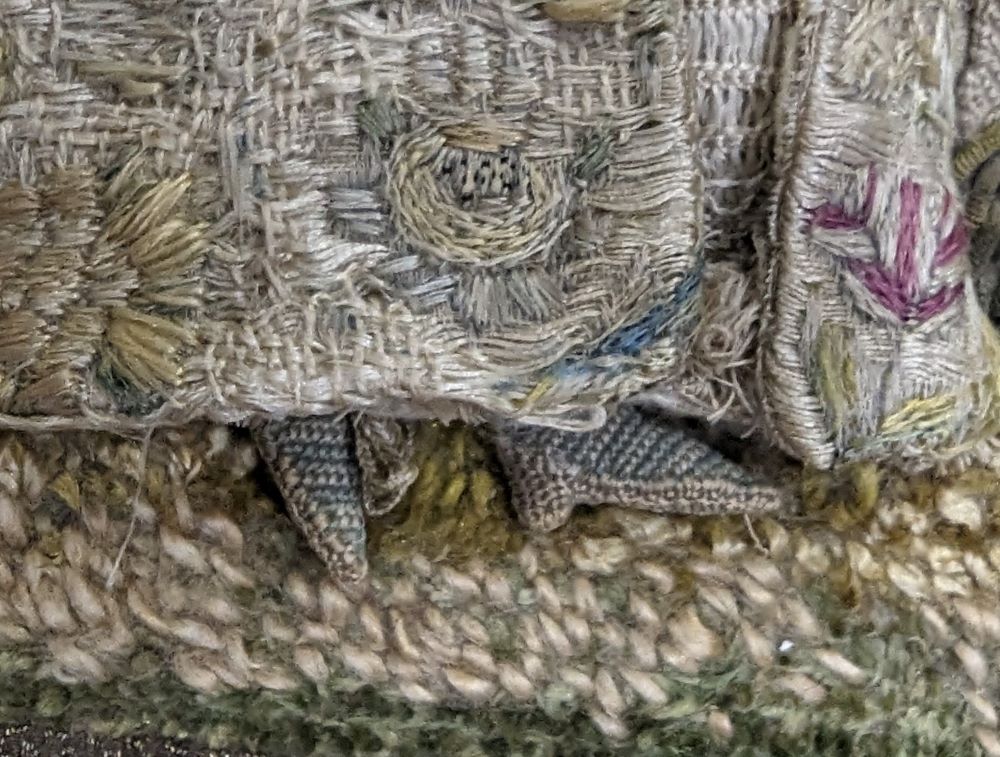Many years ago, I was preparing to teach a class on 17th century raised embroidery techniques. As I was also working on a history module for the BA, I made my first appointments to study extant examples in museum stores. At that time, the Embroiderers’ Guild collection was housed in their apartments at Hampton Court Palace. Those apartments now house the Historic Royal Palaces Dress Collection, and the Embroiderers’ Guild Collection has moved to dedicated space in an accredited museum store and items are on display on a rotating basis in a permanent gallery space in the Discover Buck’s Museum in Aylesbury.



On our way to the museum store, we stopped in at St. Peter’s Church in East Halton. Challe’s main interest is not embroidery but church brasses and there was one she hadn’t yet photographed. As I wandered around, I spied this beautiful banner of the Archangel Michael defeating the dragon. The figures are painted and the details are embroidered. The brownish velvet panels are also embroidered but the narrow trim is painted. The painted areas have held together but the horizontal threads of the background silk hang loose because the vertical threads have disappeared. The angel has such a lovely face but the banner will probably disintegrate as it hangs on the church wall so I thought I’d take a few images so it would be remembered… I have come across many beautiful banners such as this as I travel through the country and it saddens me to think they will all eventually turn to dust.
We arrived at the museum storage building and were greeted by the curator, the photographer and the creative director of the Embroiderers’ Guild Collection who guided us through the earliest embroideries in the collection. Unfortunately, there are few 16th century examples but there are some lovely early (and later) 17th century embroideries that were well worth examining.


These two small blackwork motifs are dated to the Tudor period. The gillyflower is quite threadbare but the honeysuckle is in very good condition with most of the black thread still in place. It looks like it has been damaged, possibly in a fire, and that is likely the reason that they have been cut from their original ground and secured to new pieces of linen. The counted patterns are classic and can probably be found in the older books on blackwork such as the ones by Moyra McNeil and Elisabeth Geddes, Margaret Pascoe and Louisa Pesel.



We looked at two coifs – the berry coif and the more colourful flower coif. More information on the berry coif can be found in Jacqui Carey’s Elizabethan Stitches. The pea pods on the colourful coif are detached buttonhole and can be lifted to reveal little peas but I didn’t get a very good image.

The rest of the items we saw were much later but still very informative. The raised work picture is actually the top of a box illustrating a biblical Bathsheba bathing in a square pool with a water spout in the shape of a fish head. The close ups show quite a few remarkable details such as the carved wooden hands of the figure on the left. Her collar has a pattern and a tatted (?) lace edging and quite a large insect is hovering just over her shoulder. Her left shoe is covered very delicately with buttonhole and you can see the looped shoelace. I love that the tops of the shoes are blue and the heal and soles are easily distinguished because they are stitched at an angle to the blue tops and in a different colour. Althea very carefully lifted the lined skirt panel to reveal the striped petticoat underneath with a lace trim and a fringe.



The final two pictures this week are of brasses in a Sussex church. The first is a 17th century brass image of Elizabeth Culpepper (d. 1534) whose dress is quite similar to the one on the box. The second is another Elizabeth Culpepper but her costume reflects the date of her death at a much earlier date (c. 1510).



Regarding the two blackwork motifs you saw in the Guild’s Collection, I wrote an article on how they might have fitted with another blackwork object (EG169) in the collection. See Embroidery Volume 61 September/October 2009 p48-51 “A Mystery solved – or is it? (blackwork in the Embroiderers’ Guild Museum Collection)”.
Thank you Chris. I should have mentioned that there are quite a few articles on items in the Guild’s collection that have been published in Embroidery magazine. If you don’t subscribe, you can purchase back issues at https://embroiderymagazine.co.uk/subscribe/embroiderymag-back-issues/
There are also a number of articles in past Stitch (with the Embroiderers’Guild) magazines referencing the Guild’s collection.
Thank you so much for taking me/us along on your travels. You give us such wonderful access and commentary.
I join you in mourning the silk in the St Michael banner. Do you have information, or a guess, about its age?
Thank you for your comment and question! This really isn’t my area, but I’d hazard a guess at late 19th early 20th century. If you want to know more about ecclesiastical embroidery from this period, Mary Schoeser’s English Church Embroidery 1833-1953 is a good reference. Also the Elizabeth Hoare Embroidery Gallery in Liverpool Cathedral is probably worth a visit although there isn’t much about it on the cathedral website. I haven’t been myself but it is on the list!
Thanks! That’s the time period I’d have guessed, plus you’ve given me a new place for my want-to-visit list. (Rebecca Brent)
I’ve read your article. Honestly, I’ve never read this type of informative and efficient article before. This article will help lots of beginners like me to build skills in embroidery. Love to read your incoming blogs too. Really appreciate your work and dedication.